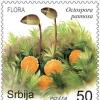
15-03-2019 16:20
Thorben HülsewigHi there, some days ago i found on Malus bark thi

14-03-2019 18:27
 Christian Schwarz
Christian Schwarz
Found on leaves of planted (non-native) Cordyline

14-03-2019 12:55
Dragiša SavicHi to all,I found on the seed of Cornus mas intere

13-03-2019 17:34
 Joop van der Lee
Joop van der Lee
Found on deer dung.Pseudothecia: globose.Asci: 8-s

14-03-2019 00:09
Elsa SousaGood evening,I found these ascomata on a dead bran

14-03-2019 16:25
me mandan elmaterial de Galicia, recolectado en

09-03-2019 18:48
 Marc Detollenaere
Marc Detollenaere
Dear Forum, This morning in a small forest with A
holidays
Marcel Vega,
12-03-2019 22:54
here's a brief information for anybody going to Serbia this year -there's a nice new stamp to frank your postcards with...
Cheers,
Marcel
Thomas Læssøe,
13-03-2019 10:27
Re : holidays
super nice!
Chris Yeates,
13-03-2019 18:25

Re : holidays
If someone wants to send me a postcard with this stamp, I'll happily repay them!
:-) Chris
Dragiša Savic,
15-03-2019 22:13
Re : holidays
No problem
Dragiša (the main culprit for the existence of this stamp :-))
Dragiša (the main culprit for the existence of this stamp :-))
